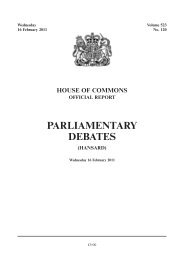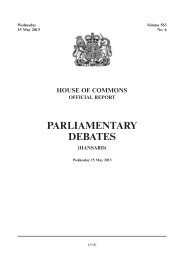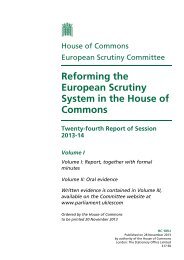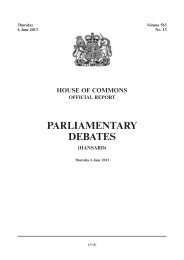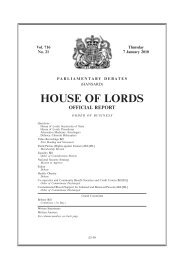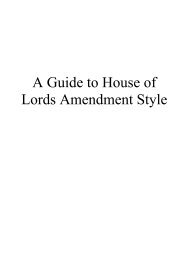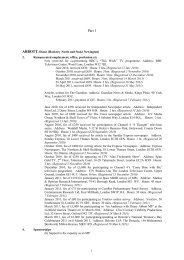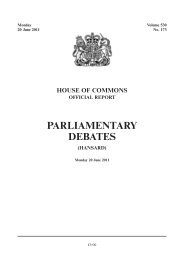here - United Kingdom Parliament
here - United Kingdom Parliament
here - United Kingdom Parliament
Create successful ePaper yourself
Turn your PDF publications into a flip-book with our unique Google optimized e-Paper software.
901 National Policy Statements 1 DECEMBER 2010 National Policy Statements 902<br />
We believe that the revised appraisals put readers in a<br />
much better position to evaluate the revised draft NPSs.<br />
The revised AOSs give a clear picture of the likely<br />
significant impacts at the strategic level of consenting<br />
energy infrastructure projects in accordance with the<br />
NPSs, by reference to a wide range of relevant<br />
environmental, social and economic factors. They also<br />
explain more clearly why we have not chosen a number<br />
of alternative policies that others proposed, but which<br />
would not have been as good in meeting our overall<br />
objectives of maintaining safe, secure and affordable<br />
energy supplies while moving to a low carbon economy<br />
and reducing carbon emissions by 80% by 2050.<br />
We have made significant changes to the statement of<br />
need in the overarching national policy statement. It<br />
now includes research that was not available for the first<br />
draft, including more detailed analysis of scenarios to<br />
achieve an 80% reduction in carbon emissions by 2050.<br />
We have also included more detail on what is required<br />
for an economic feasibility assessment to ensure that<br />
fossil fuel generating stations are carbon capture-ready.<br />
Neil Carmichael: The NPS gives great support to<br />
those of us who support a green investment bank<br />
because it provides a framework for investment, which<br />
is necessary to the platform of support that investors<br />
might require. How important does the Minister think<br />
the green investment bank will be in delivering some of<br />
the outcomes?<br />
Charles Hendry: The Government have committed<br />
£1 billion to the green investment bank, with additional<br />
funding to follow in due course. I am extremely pleased<br />
that the Environmental Audit Committee is to examine<br />
how the bank might work. Infrastructure banks in<br />
other countries—for example, the one in Holland, which<br />
was funded with ¤2 billion of initial capital, but brought<br />
in ¤100 billion of additional finance—can play a critical<br />
role, particularly in getting business through the so-called<br />
valley of death.<br />
Returning to the technology-specific NPSs, we have<br />
revised the fossil fuels policy statement—document<br />
No. 2—to clarify the requirements for carbon capture<br />
readiness in terms of technical and economic feasibility<br />
in line with the request made by the Energy and Climate<br />
Change Committee.<br />
Ian Lavery (Wansbeck) (Lab): On carbon capture<br />
and storage, will new applications for gas-fired power<br />
stations be treated the same as applications for new<br />
coal-fired power stations in that they will have to be<br />
carbon capture-ready before they can be accepted at the<br />
planning stage?<br />
Charles Hendry: A new coal plant will have to be<br />
equipped with some degree of carbon capture and<br />
storage capability—we have made it clear that t<strong>here</strong> will<br />
be no role for unabated coal in the future—w<strong>here</strong>as a<br />
new gas plant will have to be carbon capture-ready,<br />
because of the much lower levels of emissions associated<br />
with modern gas plants. Emissions from the most efficient<br />
coal plant are perhaps 750 grams per kWh, w<strong>here</strong>as the<br />
figure for the most sophisticated gas plant is perhaps<br />
350 grams per kWh. Given the significant difference in<br />
emission levels, we are looking at requiring CCS to be<br />
part of the programme. That is why we have allocated<br />
£1 billion, which is more than any Government anyw<strong>here</strong><br />
in the world have allocated to a single plant. We are<br />
keen to take forward the development, but we have also<br />
said that as part of the subsequent pilot projects 2 to 4,<br />
we are keen to see whether that can be applied to gas.<br />
Ian Lavery: The Minister said that £1 billion had<br />
been invested in the carbon capture and storage programme.<br />
T<strong>here</strong> were four initial demonstration plants, the first of<br />
which is to be a coal-fired demonstration plant. The<br />
contract will be awarded, I believe, in December 2011.<br />
Will that not take most of the £1 billion? If so, is he<br />
confident that moneys will be available to secure the<br />
phase 2, 3 and 4 carbon capture and storage projects?<br />
Charles Hendry: The hon. Gentleman makes an<br />
important point. The £1 billion is specifically and only<br />
for that project. As I said, that is more than any Government<br />
anyw<strong>here</strong> in the world have allocated to a single project.<br />
The additional plants will be funded either by the levy<br />
introduced in the Energy Act 2010, or from general<br />
taxation. We are looking at the best way forward in<br />
terms of deliverability and the Treasury is examining<br />
the issue. The funding of projects 2 to 4 is separate from<br />
the funding of project 1, which has the £1 billion<br />
available to it.<br />
The revised renewables NPS has taken particular<br />
account of comments on biomass sustainability for<br />
generating stations using biomass as fuel. We have also<br />
revised the text regarding noise from onshore wind<br />
farms, which is different from general industrial noise,<br />
so a specific assessment methodology is used to take<br />
that into account.<br />
The method of assessing noise from a wind farm is<br />
described in “The Assessment and Rating of Noise<br />
from Wind Farms”, known as ETSU-R-97. The report<br />
recommends noise limits that seek to protect the amenity<br />
of those living close to wind farms. The recommended<br />
noise levels are determined by a combination of absolute<br />
noise limits and noise limits relative to the existing<br />
background noise levels around the site at different<br />
wind speeds.<br />
Policy document 4 relates to gas supply and oil<br />
pipelines. We have clarified that the gas supply infrastructure<br />
and gas and oil pipelines NPS covers only oil and<br />
natural gas pipelines and not CO 2 pipelines, which will<br />
be an important matter in relation to carbon capture<br />
and storage development. We have also added a new<br />
section describing the impacts on gas emissions due to<br />
the flaring or venting of gas.<br />
Policy paper 5 relates to electricity networks. We have<br />
tried to make sure that Government policy on<br />
undergrounding and the need to treat each application<br />
case by case is expressed more clearly. I welcome the<br />
decision by the Institute of Engineering and Technology<br />
to make an authoritative investigation of the costs of<br />
undergrounding, particularly in relation to the issues<br />
that the hon. Member for Wells (Tessa Munt) has<br />
raised, so that we can have a clear fact-based assessment<br />
of the different costs involved.<br />
Tessa Munt (Wells) (LD) rose—<br />
Charles Hendry: I thought that might encourage the<br />
hon. Lady.



